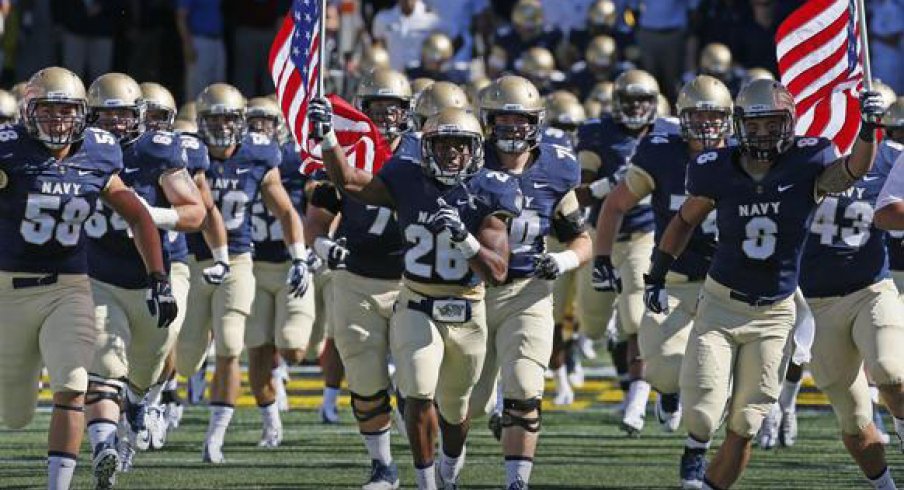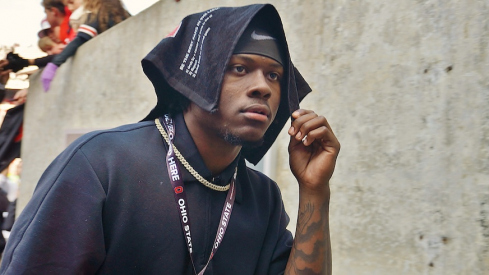The U.S. Naval Academy's football team has been known for their trademark 'flexbone' triple-option scheme on offense for years.
This past spring, I broke down the basics of their offense HERE, and what it takes for a team to stop it HERE. If you are unfamiliar with the Midshipmen offensive attack, I recommend taking a look at those two articles and familiarizing yourself with their triple-option scheme before kickoff on Saturday. Their version of the flexbone is a very unique scheme, yet has proven for years to be a very successful one as well.
Although it's almost always overlooked in comparison to the offense, Navy also plays defense and, like you might expect from a service academy football team, this unit has some unique quirks of its own.
PERSONNEL
The Midshipmen run a modified version of the 3-4 defense, that often times looks more like a 4-2-5 scheme you might see from TCU. For many of the same reasons offenses began spreading out their formations to take advantage of smaller players over the past decade, the Naval Academy defense tries to use speed to make up for their lack of size. Also much like TCU, Navy runs almost exclusively Cover 4 in the secondary, keeping two safeties deep at nearly all times.

Right off the bat, there are a few things that stand out when comparing this unit to a 3-4 defense you might see run on Sundays by the Pittsburgh Steelers or Dallas Cowboys.
First and foremost, the SAM outside linebacker, #13 Jordan Drake, lines up like a defensive end in most situations. He can often be found up on the line of scrimmage, at the end closest to the sideline in a 2 point stance, and rushing the QB in passing situations. Drake has good size for an outside linebacker, at 6'4" and 220 lbs, but is often matched up against offensive tackles that have 100 lbs on him.
His counterpart at outside linebacker, #46 Chris Johnson, is much smaller at 6'1" 207 lbs, but often plays outside of the box and opposite Drake to the wide side of the field. His role is very similar to that of OSU SAM linebacker Darren Lee, lined up wide over near a slot receiver, playing in the "alley" between the end man on the offensive line (a tackle or tight end) and a wide receiver on the outside.
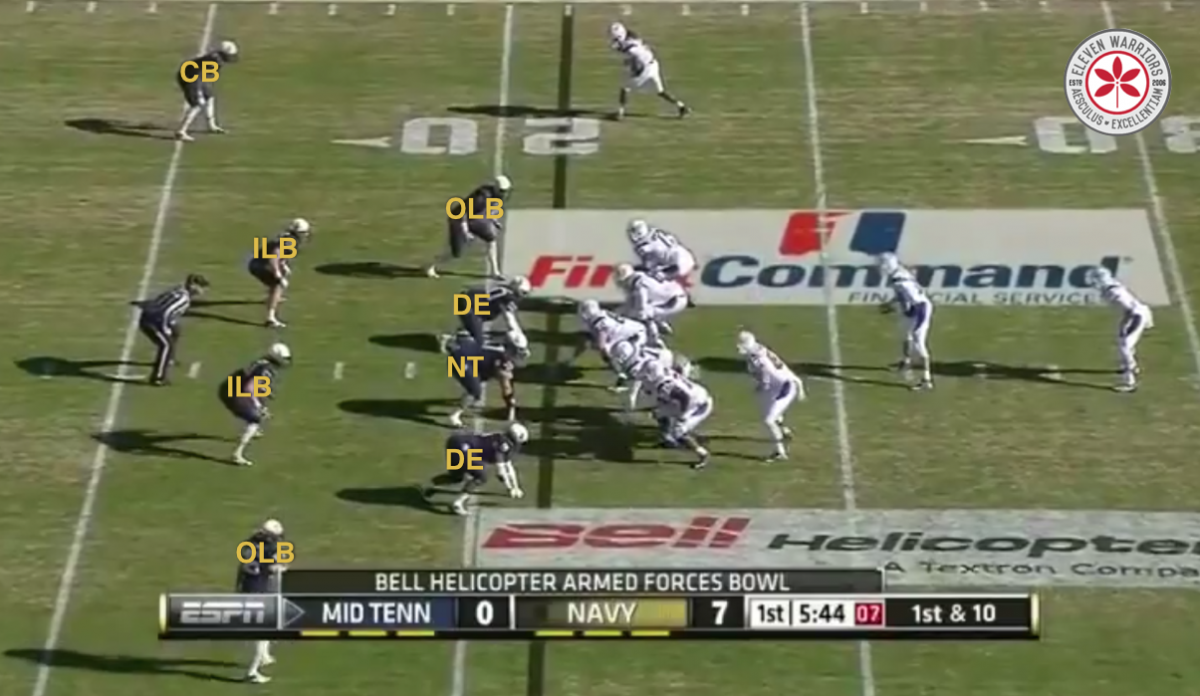
With a closer view of Navy's front seven on a different play, we can see another example of the outside linebackers' alignment, but we also get a better idea of the defensive line's alignment.
The Midshipmen only have two defensive linemen listed at over 300 lbs in their depth chart, and both play nose tackle. In fact, #77 Bernard Sarra and #68 Rob Forrestal are the only defensive linemen listed above 268 lbs on that chart. Unlike NFL 3-4 defensive ends like former Buckeye Cameron Heyward that often come in above 300 on the scales, the Navy ends are much smaller, usually around 250 lbs and relying on their speed to make plays.
These ends don't swap side based on the strength of the offensive formation, and simply play left and right end. When the SAM is on their side though, the bump down inside like a defensive tackle, as we see from the left end above. The right end, however, is lined up way outside in a "9-technique" much like the SAM to the opposite side.
RUN DEFENSE
With such a wide alignment from a defensive end and SAM linebacker, as well as a lack of big bodies to defeat double teams, the Navy inside linebackers are relied heavily upon to make plays against the run. Although both have since graduated, the starting Midshipmen inside 'backers tallied an astounding 252 tackles combined in 2013.
Their replacements, #51 James Britton and #38 William Tulder, offer good size for collegiate linebackers, but are often fighting off blockers as they're usually called upon to take on anything in the "B" gaps between the guards and tackles of the opposing offensive line.

The nose tackle and one of the ends usually take on the "A" gaps on either side of the center, with the other end and the SAM responsible for the "C" gaps outside the tackle. When a tight end is present, the "D" gap on the outside is often then the responsibility of either Johnson at OLB or one of the safeties.
In many traditional 3-4 schemes, the defensive line tries to occupy as many blockers as possible, clogging holes and leaving the linebackers free to make tackles. Beyond the oversized nose tackles though, the Navy ends instead try to penetrate gaps, using their speed to beat slower and bigger offensive linemen.
With the front seven players in the defense so spread out, the Buckeyes may have trouble executing their double-team blocks when running the tight zone, something OSU tackle Taylor Decker mentioned earlier this week. Offensive Linemen don't typically like having to chase a defender to block him. Though the Navy defense should be fairly easy to block once the much bigger Buckeyes get their hands on them, the already inexperienced Ohio State offensive line could easily wear down and get frustrated with this kind of activity.
To counter this, my guess is the Buckeyes will turn to the "Power-O" play quite a bit more than we've often seen from them in the past under Urban Meyer and offensive coordinator Tom Herman. The OSU offensive line can get an easy double team on the Navy nose tackle in the A gap with the center and guard to that side, while still accounting for the inside linebacker with the pulling backside guard.
Middle Tennessee State saw a great deal of success with this play in the Armed Forces Bowl last December, something Meyer and his staff surely noticed.
Finally, I'd expect to see the Buckeyes line up tight ends Jeff Heuerman and Nick Vannett to the short side of the field quite a bit. Although the two have been very successful as blockers when lined up in the backfield, by lining up on the line next to a tackle, they create an additional gap to defend. With the SAM to that side, the deep safety behind him will now be forced to come up in run defense to help cover a now exposed gap.
PASS DEFENSE
As mentioned before, the Naval Academy runs cover 4 "quarters" coverage almost exclusively against spread offenses like Ohio State's. Due to the challenges of recruiting for a service academy, the Midshipmen don't have the athletes to match the receivers they often see in one-on-one situations, and instead play fairly conservative in the secondary.
Both safeties are often lined up deep and out of the screen on TV broadcasts, and immediately look to gain depth after the snap. Unlike what we've seen thus far from the cornerbacks in OSU defensive coordinator Chris Ash's cover 4 scheme, Navy's corners play very far off the ball, trying to keep everything in front of them and not getting beat deep.
But although the defensive backs play a brand of conservative, yet consistent, defense, the Navy pass defense gets into trouble underneath when the linebackers get involved. As we can see from this example from Armed Forced Bowl, Middle Tennessee State has lined up in a 3x1 formation, overloading the wide side of the field with three eligible receivers.
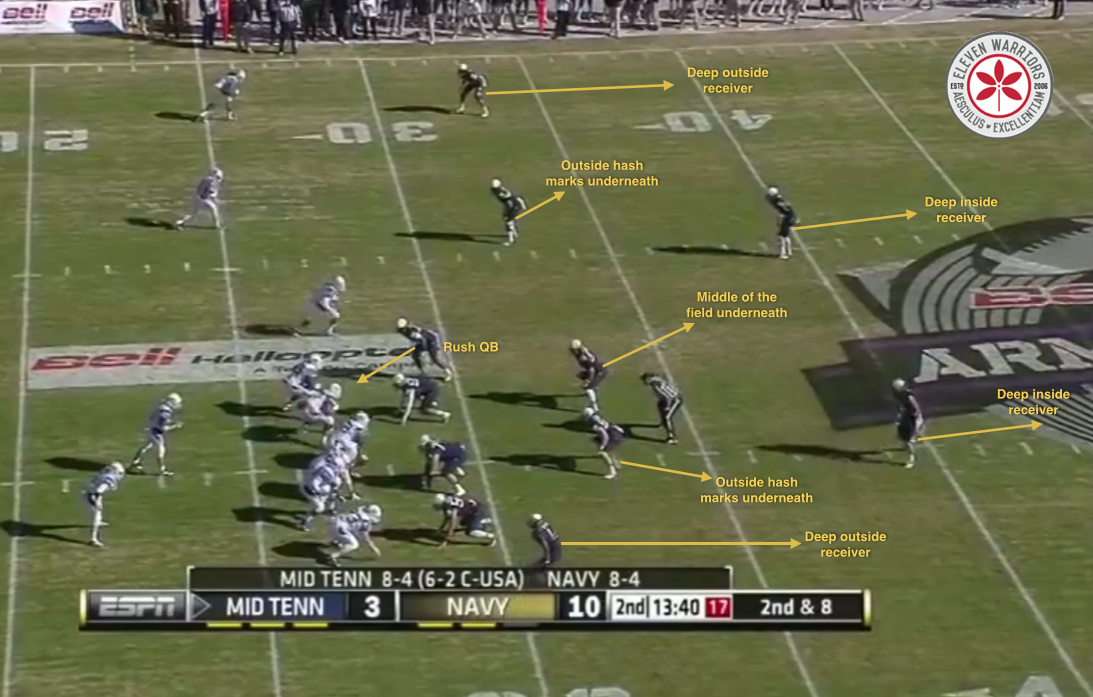
Although MTSU has stressed the wide side of the field, the only change in alignment was to bring the SAM linebacker over to that side, even though he is still called on to rush the QB.
Almost immediately, the OLB to the wide side, Johnson, finds himself in trouble, as no one has bumped out to help him cover the two inside receivers.
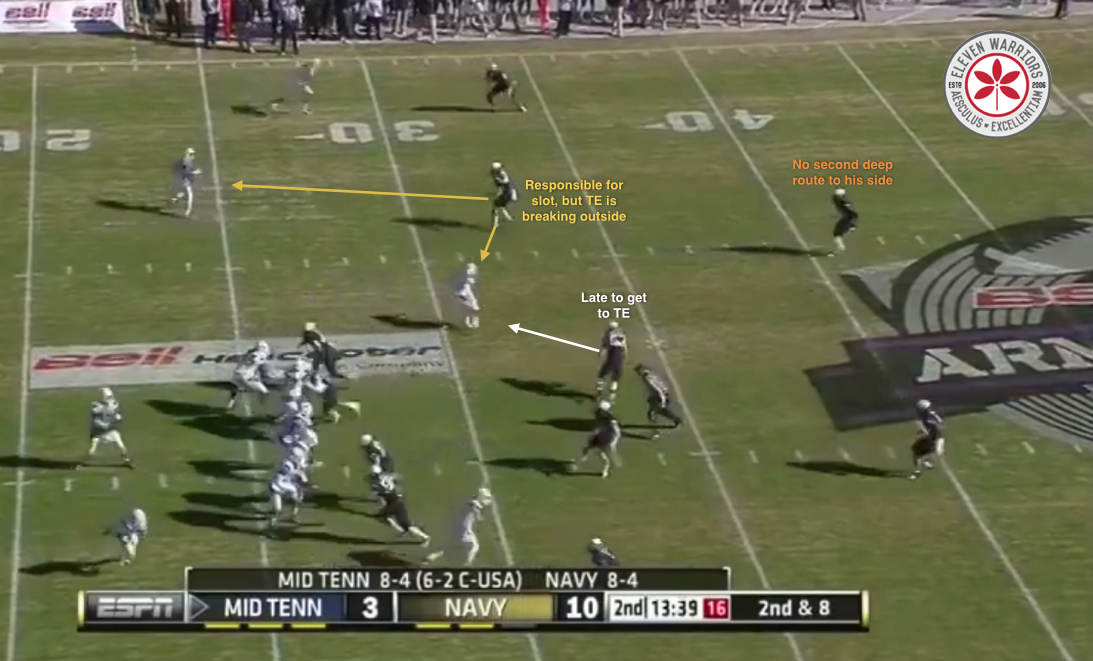
The #2 receiver has stayed short and run a screen pattern, while the #3 receiver (a tight end) runs a short, out-breaking route right toward his zone. In theory, the OLB should be responsible for the screen, with the safety and inside linebacker covering the tight end. Yet the linebacker is late reading the route, and the safety does nothing to step up, as he doesn't want to get beat deep.
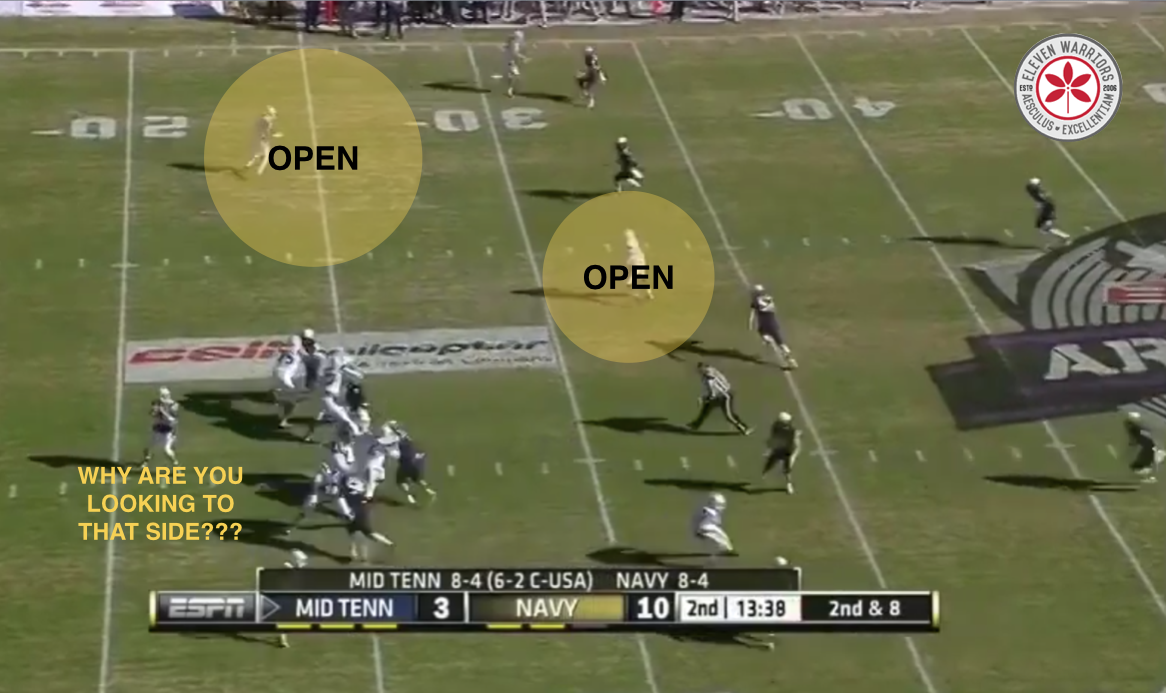
For whatever reason, the MTSU QB never even looks to that side, instead focusing on his running back out of the backfield almost exclusively. Yet had he even glanced the other way, he could've made an easy throw to the tight end who didn't have a defender within four yards of him, or thrown the screen to the slot man and let him make a play in space against the OLB, the only potential tackler within ten yards.
Navy's linebackers are forced to worry about stopping the run first, and can easily be stretched in the underneath passing game, as we see in this example against MTSU.
Luckily for the Buckeyes, this weakness plays right into the passing concepts we saw from JT Barrett in the spring game, and will likely see all season with him at QB.
The key player in the Navy pass defense will likely be Johnson at this hybrid OLB spot, who will be asked to contain the Buckeye "H" receivers of Dontre Wilson and Jalin Marshall in the slot. Though Johnson is a decent athlete for the position and has a lot of experience, he is clearly over-matched by the athleticism of Wilson and Marshall. Near the goal-line, the size of Heuerman and Vannett could cause him major headaches as well, if the Buckeyes so choose to exploit it.
I expect to see the Buckeyes use a lot of packaged plays, combining a running play with a screen to Wilson, looking to get the ball to their playmakers quickly and forcing Johnson to make numerous tackles in space. Additionally, the potential handoff to the running back will cause the Navy linebackers to declare very early where their priorities lie, leaving an area of the field wide open.
The combination of "Power-O" with a wide-receiver screen is already a staple of the OSU playbook, so asking Barrett and company to execute shouldn't be a huge ask at this point.

Overall, the Buckeyes have a clear athletic edge over Navy's defense, even without Braxton Miller. While JT Barrett is making his first start, so are Navy's inside linebackers, and I expect Meyer and Herman to force them into uncomfortable situations, guessing run or pass, or chasing a much quicker receiver in their zone.
The Buckeyes don't need to re-write the playbook to beat this defense, as the core schemes are in place to take it apart. If they're able to execute, we'll be seeing a lot of points from the Scarlet & Gray.
